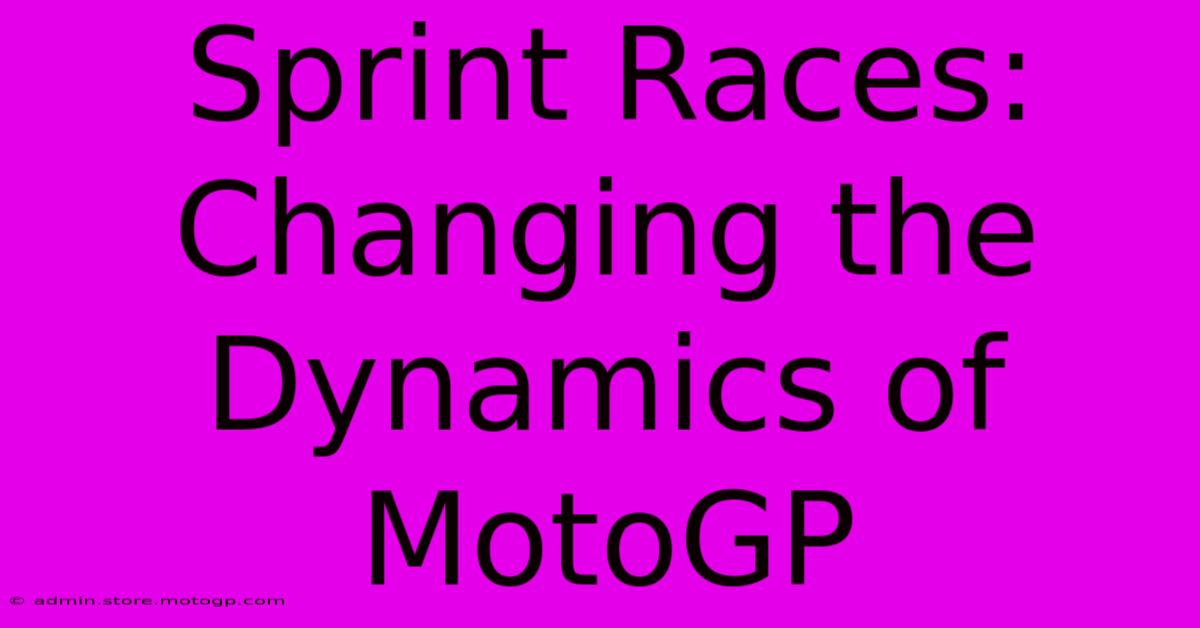Sprint Races: Changing The Dynamics Of MotoGP

Table of Contents
Sprint Races: Changing the Dynamics of MotoGP
The roar of the engines, the smell of burning rubber, the breathtaking speeds – MotoGP is a spectacle unlike any other. But in recent years, a new element has been injected into the already electrifying mix: sprint races. These shorter, faster bursts of adrenaline have fundamentally altered the dynamics of the championship, sparking debate and excitement in equal measure. This article delves into the impact of sprint races on MotoGP, exploring both their benefits and drawbacks.
The Rise of the Sprint Race: A New Era in MotoGP
Introduced in 2023, sprint races are essentially mini-GPs held on the Saturday of a race weekend, awarding points to the top nine finishers. This addition has dramatically reshaped the weekend's structure and the overall strategic approach of teams and riders. No longer is Friday solely for practice; now, it's a crucial stepping stone to Saturday's sprint and Sunday's main Grand Prix.
Increased Action and Excitement
The most immediate and obvious impact of sprint races is the increased level of on-track action. The shorter race format encourages more aggressive overtaking and risk-taking, leading to thrilling battles and unpredictable results. For fans, this translates to more excitement and a higher level of engagement throughout the weekend. This heightened intensity also keeps viewers glued to their screens, boosting viewership figures and potentially attracting new audiences.
A Shift in Strategic Planning
Sprint races have forced teams and riders to rethink their race strategies. The need to balance performance in both the sprint and the main race necessitates careful tire management and bike setup choices. The added pressure of two races in a weekend also plays a significant role, impacting rider fatigue and bike maintenance. This strategic complexity adds another layer to the sport's already intricate gameplay.
A More Competitive Championship
The awarding of points in sprint races has made the championship battle even more fiercely contested. Even riders who struggle in the main Grand Prix can accumulate crucial points in the sprint, maintaining a competitive position in the overall standings. This creates a more level playing field and enhances the overall competitiveness of the championship. It also gives riders more opportunities to demonstrate their skills and potentially climb the rankings.
The Downsides of Sprint Races: A Critical Perspective
While sprint races have undoubtedly injected a dose of excitement into MotoGP, they are not without their drawbacks.
Increased Physical and Mental Strain on Riders
The added pressure and intensity of two races in a weekend puts a significant strain on riders both physically and mentally. Increased fatigue can lead to errors and potentially increase the risk of injuries. The demanding nature of the sprint race format could lead to burnout over the course of a long season.
Potential for Damage and Mechanical Issues
The higher intensity of sprint races increases the risk of crashes and mechanical issues, potentially impacting riders' performance in the main Grand Prix. A damaged bike in the sprint could ruin a rider's chances of scoring points in the more important Sunday race, leading to frustration.
Impact on Qualifying Significance
The introduction of sprint races has somewhat diminished the significance of qualifying. While grid position for the sprint is determined by qualifying, the actual impact on the race's outcome might be less significant than before. This change in emphasis might detract from the thrill of the traditional qualifying sessions.
The Future of Sprint Races in MotoGP
The jury is still out on the long-term effects of sprint races on MotoGP. While the increased excitement and enhanced competitiveness are undeniable benefits, the potential downsides need careful consideration. As the format continues to evolve and data on its impact accumulates, Dorna Sports (the commercial rights holder for MotoGP) will undoubtedly need to refine the system, addressing concerns about rider fatigue and ensuring a balance between excitement and safety. The future of sprint races in MotoGP will depend on this ongoing evaluation and adaptation. One thing is certain: sprint races have irrevocably altered the landscape of MotoGP, creating a more dynamic and engaging championship for both riders and fans.

Thank you for visiting our website wich cover about Sprint Races: Changing The Dynamics Of MotoGP. We hope the information provided has been useful to you. Feel free to contact us if you have any questions or need further assistance. See you next time and dont miss to bookmark.
Featured Posts
-
Cota Grandstands The Ultimate Race Day Investment
Feb 19, 2025
-
Yamaha V4 A Motorcycle That Will Make You Smile
Feb 19, 2025
-
Any Racing On Tv Today Free And Paid Options
Feb 19, 2025
-
Race Bred Power Explore Our Selection
Feb 19, 2025
-
Cota Merch The Ultimate Racing Souvenir
Feb 19, 2025
